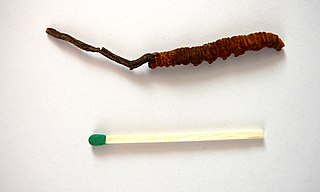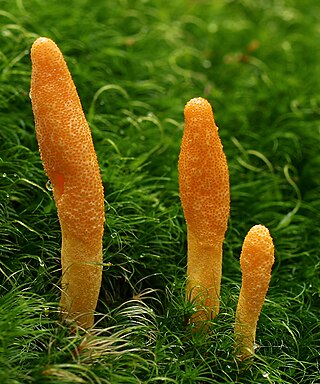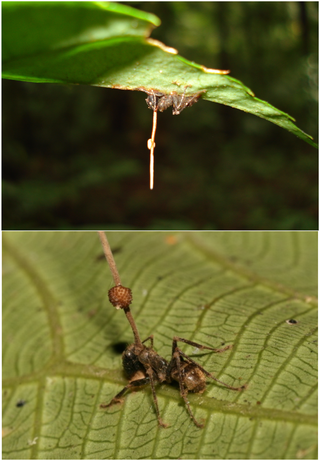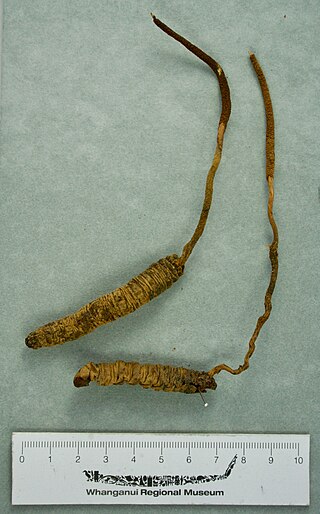
Basidiomycota is one of two large divisions that, together with the Ascomycota, constitute the subkingdom Dikarya within the kingdom Fungi. Members are known as basidiomycetes. More specifically, Basidiomycota includes these groups: agarics, puffballs, stinkhorns, bracket fungi, other polypores, jelly fungi, boletes, chanterelles, earth stars, smuts, bunts, rusts, mirror yeasts, and Cryptococcus, the human pathogenic yeast.

Ophiocordyceps sinensis, known colloquially as caterpillar fungus, is an entomopathogenic fungus in the family Ophiocordycipitaceae. It is mainly found in the meadows above 3,500 metres (11,500 ft) on the Tibetan Plateau in Tibet and the Himalayan regions of Bhutan, India, and Nepal. It parasitizes larvae of ghost moths and produces a fruiting body which is valued in traditional Chinese medicine as an aphrodisiac. Caterpillar fungus contains the compound cordycepin, an adenosine derivative. However, the fruiting bodies harvested in nature usually contain high amounts of arsenic and other heavy metals, so they are potentially toxic and sales have been strictly regulated by China's State Administration for Market Regulation since 2016.

Cordyceps is a genus of ascomycete fungi that includes about 600 worldwide species. Diverse variants of cordyceps have had more than 1,500 years of use in Chinese medicine. Most Cordyceps species are endoparasitoids, parasitic mainly on insects and other arthropods ; a few are parasitic on other fungi.
In mycology, the terms teleomorph, anamorph, and holomorph apply to portions of the life cycles of fungi in the phyla Ascomycota and Basidiomycota:
Hyphomycetes are a form classification of fungi, part of what has often been referred to as fungi imperfecti, Deuteromycota, or anamorphic fungi. Hyphomycetes lack closed fruit bodies, and are often referred to as moulds. Most hyphomycetes are now assigned to the Ascomycota, on the basis of genetic connections made by life-cycle studies or by phylogenetic analysis of DNA sequences; many remain unassigned phylogenetically.

Ophiocordyceps unilateralis, commonly known as zombie-ant fungus, is an insect-pathogenic fungus, discovered by the British naturalist Alfred Russel Wallace in 1859, and currently found predominantly in tropical forest ecosystems. O. unilateralis infects ants of the tribe Camponotini, with the full pathogenesis being characterized by alteration of the behavioral patterns of the infected ant. Infected hosts leave their canopy nests and foraging trails for the forest floor, an area with a temperature and humidity suitable for fungal growth; they then use their mandibles to attach themselves to a major vein on the underside of a leaf, where the host remains after its eventual death. The process, leading up to mortality, takes 4–10 days, and includes a reproductive stage where fruiting bodies grow from the ant's head, rupturing to release the fungus's spores. O. unilateralis is, in turn, also susceptible to fungal infection itself, an occurrence that can limit its impact on ant populations, which has otherwise been known to devastate ant colonies.

The Orbiliaceae are a family of saprobic sac fungi in the order Orbiliales. The family, first described by John Axel Nannfeldt in 1932, contains 288 species in 12 genera. Members of this family have a widespread distribution, but are more prevalent in temperate regions. Some species in the Orbiliaceae are carnivorous fungi, and have evolved a number of specialized mechanisms to trap nematodes.

Ophiocordyceps is a genus of fungi within the family Ophiocordycipitaceae. The widespread genus, first described scientifically by British mycologist Tom Petch in 1931, contains about 140 species that grow on insects. Anamorphic genera that correspond with Ophiocordyceps species are Hirsutella, Hymenostilbe, Isaria, Paraisaria, and Syngliocladium.
Podonectria is a genus in the monotypic Podonectriaceae family of fungi. They are parasitic fungus on scale insects, other fungi, or on substrates that had previously colonized by other fungi.

Isaria sinclairii is a species of entomopathogenic fungus mostly infecting the underground nymphs of cicadas. It produces myriocin, from which the synthetic drug fingolimod, a treatment for multiple sclerosis, was developed.
Ophiocordyceps camponoti-balzani is a species of fungus that parasitizes insect hosts of the order Hymenoptera, primarily ants. It was first isolated from Viçosa, Minas Gerais, on Camponotus balzani. This species was formerly thought to be Ophiocordyceps unilateralis, which has subsequently been divided into four species. O. camponoti-balzani infects ants, and eventually kills the hosts after they move to an ideal location for the fungus to spread its spores. This has earned the species names such as “zombie fungus”, given the fungus has been observed to cause its hosts to bite hard into the substrate it stands on, so that the fungus can then stably grow.

Dumbletonius unimaculata is a species of moth of the family Hepialidae. It is endemic to New Zealand. This species is host to the vegetable caterpillar fungus Ophiocordyceps robertsii.

Ophiocordyceps nutans is an entomopathogenic fungus belonging to the order Hypocreales (Ascomycota) in the family Ophiocordycipitaceae. O. nutans only parasitizes Hemipterans, namely stinkbugs. In Korea, O. nutans is one of the most common species of Cordyceps. O. nutans, as well as other Cordyceps species, are mainly classified morphologically by their colour, fruit body shape, and host insect species. Stinkbugs cause considerable damage to agriculture and forestry, and the anamorph of O. nutans, Hymenostilbe nutans, is a potential selective biological control agent against the stinkbugs.
Ophiocordyceps arborescens is an entomopathogenic fungus belonging to the order Hypocreales (Ascomycota) in the family Ophiocordycipitaceae. It produces superficial, oval perithecia at the apex of its stroma, and also multiseptate ascospores, while producing Hirsutella-type anamorphs on growth culture media. They are particularly distinguished by the shape and size of their stroma.
Ophiocordyceps coenomyia is an entomopathogenic fungus belonging to the order Hypocreales (Ascomycota) in the family Ophiocordycipitaceae. It is parasitic to awl-fly larvae. This species is characterized by a globose, alutaceous fertile part at the apex of its light yellow stroma, its immersed perithecia, and ascospores dividing in turn into partspores. The species is closely related to O. heteropoda.
Ophiocordyceps camponoti-novogranadensis is a species of fungus that parasitizes insect hosts, in particular members of the order Hymenoptera. It was first isolated from Parque Estadual de Itacolomi in Ouro Preto, at an altitude of 1,000 metres (3,300 ft), on Camponotus novogranadensis.
Ophiocordyceps camponoti-melanotici is a species of fungus that parasitizes insect hosts, in particular members of the order Hymenoptera. It was first isolated from Viçosa, Minas Gerais, on Camponotus melanoticus.

Ophiocordyceps robertsii, known in New Zealand as vegetable caterpillar is an entomopathogenic fungus belonging to the order Hypocreales (Ascomycota) in the family Ophiocordycipitaceae. It invades the caterpillars of leaf-litter dwelling moths and turns them into fungal mummies, sending up a fruiting spike above the forest floor to shed its spores. Caterpillars eat the spores whilst feeding on leaf litter to complete the fungal life cycle. Evidence of this fungus can be seen when small brown stems push through the forest floor: underneath will be the dried remains of the host caterpillar. This species was first thought by Europeans to be a worm or caterpillar that burrowed from the top of a tree to the roots, where it exited and then grew a shoot of the plant out of its head. It was the first fungus provided with a binomial name from New Zealand.
Capronia mansonii is a mesophilic black yeast that is a part of the Herpotrichiellaceae. The species is uncommon in nature but is saprotrophic in nature and been discovered on decaying plant matter, particularly wood. This fungus is naturally found in the Netherlands and has successfully been cultured in lab. It is a teleomorph of the ascomycota division and possesses brown spores.

Tzeanania is a monotypic genus of fungi established in 2018. It is the only genus in the family Tzeananiaceae and contains the single species Tzeanania taiwanensis. The species is a parasite which grows on fruiting bodies of the fungus Ophiocordyceps macroacicularis, which is itself a parasite of moth larvae. So far it is only known from one collection which was made in Taiwan.










